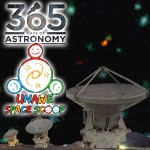Podcaster: Richard Drumm
 Title: Space Scoop: ALMA Peers Through the Fog Surrounding Early Galaxies
Title: Space Scoop: ALMA Peers Through the Fog Surrounding Early Galaxies
Organization: 365 Days Of Astronomy
Link : astrosphere.org ; http://www.spacescoop.org/en/scoops/1559/british-astronaut-blasts-off-to-international-space-station/
Description: Space scoop, news for children.
Bio: Richard Drumm is President of the Charlottesville Astronomical Society and President of 3D – Drumm Digital Design, a video production company with clients such as Kodak, Xerox and GlaxoSmithKline Pharmaceuticals. He was an observer with the UVa Parallax Program at McCormick Observatory in 1981 & 1982. He has found that his greatest passion in life is public outreach astronomy and he pursues it at every opportunity.
Today’s sponsor: This episode of “365 Days of Astronomy” is sponsored by — no one. We still need sponsors for many days in 2015, so please consider sponsoring a day or two. Just click on the “Donate” button on the lower left side of this webpage, or contact us at signup@365daysofastronomy.org.
Transcript:
This is 365 Days of Astronomy. Today we bring you a new episode in our Space Scoop series. This show is produced in collaboration with Universe Awareness, a program that strives to inspire every child with our wonderful cosmos.
Today’s story is:
ALMA Peers Through the Fog Surrounding Early Galaxies
Have you ever woken up just before sunrise and seen that it was very foggy outside, but then the Sun came up and quickly burned the fog away? Well, something similar happened in the Universe when it was very young.
Back when the first stars and galaxies formed, the Universe was filled with a thick fog of hydrogen gas. However, the Universe’s first galaxies were full of huge stars that gave off very strong Ultra Violet light.
UV light is called ionizing radiation and it eventually cleared the early galaxy’s fog-like hydrogen by ionizing it, unlike the morning Sun, which just heats the fog outside my house, causing it to disperse into the atmosphere.
That’s something we already knew about the early Universe. But what we know little about, are the first galaxies. Up to now our telescopes have only been able to see them as very faint blobs, like in the picture in today’s podcast album artwork.
But now the powerful vision of the ALMA radio telescope array is starting to change this. ALMA’s powerful antennas can photograph the galaxies with much more detail than we’ve seen before. More detail even than the Hubble Space Telescope!
A team of astronomers led by Roberto Maiolino of the Cavendish Laboratory and Kavli Institute for Cosmology, University of Cambridge, United Kingdom, pointed ALMA toward galaxies that were known to be so far away that we see them as they were only about 800 million years after the Big Bang.
The astronomers were not looking for the light from stars, but instead for the faint glow of ionized carbon called carbon II coming from the clouds of gas from which the stars were forming. They wanted to study the interaction between a young generation of stars and the cold clumps of gas that were assembling into these first galaxies.
They were also not looking for the extremely brilliant rare objects such as quasars and starburst galaxies with very high rates of star formation that had been seen up to now. Instead they concentrated on rather less dramatic, and much more common, galaxies that reionized the Universe and went on to turn into most of the galaxies that we see around us now.
From one of the galaxies — given the label BDF 3299 — ALMA could pick up a faint but clear signal from the glowing carbon II. The orange shape at the centre of the picture in today’s podcast album artwork is that cloud of atomic carbon gas. However, this glow wasn’t coming from the center of the galaxy, but rather from one side.
The center of the baby galaxy is loaded with ionizing UV light, so any carbon gas there will have been ionized and will be transparent. But this cloud of carbon is a satellite gas cloud that is in the process of falling into the galaxy and is far enough away from the UV in the galaxy center to not yet be ionized into invisibility.
Observations like this will help astronomers to investigate how the first galaxies were formed and how the first generation of stars seeded the gas clouds which came together to form the second generation of stars and the galaxies they inhabit.
Here’s a Cool Fact:
The fuzzy blobs in today’s picture are objects that are 13 billion light years away, so we’re seeing them as they existed 13 billion years ago! We can’t time travel into the past, but we can see it from here!
Thank you for listening to 365 Days of Astronomy!
End of podcast:
365 Days of Astronomy
=====================
The 365 Days of Astronomy Podcast is produced by Astrosphere New Media. Audio post-production by Richard Drumm. Bandwidth donated by libsyn.com and wizzard media. You may reproduce and distribute this audio for non-commercial purposes. Please consider supporting the podcast with a few dollars (or Euros!). Visit us on the web at 365DaysOfAstronomy.org or email us at info@365DaysOfAstronomy.org. This year we will celebrate more discoveries and stories from the universe. Join us and share your story. Until tomorrow! Goodbye!

